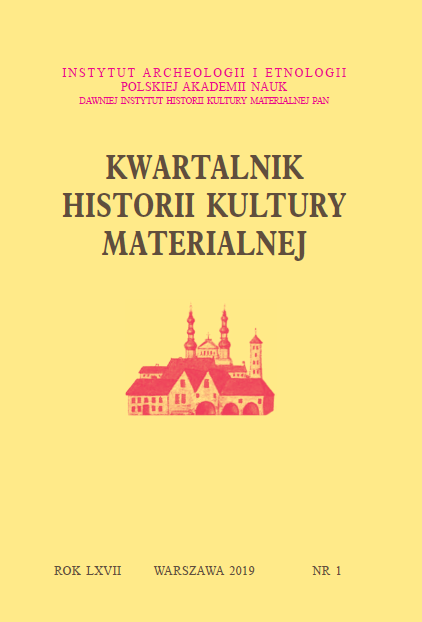The ecclesiastical proletariat? The income of the lesser clergy in the late Middle Ages exemplified with the accounting book of St. Martin’s altar in Nysa
DOI:
https://doi.org/10.23858/KHKM67.2019.1.001Keywords:
Church history, history of Silesia, clergy, Late Middle AgesAbstract
The study on the amount of income of the lesser clergy in the late Middle Ages was until now based mostly on fiscal registers. An unavoidable disadvantage of them is the recording only of an estimated sum of earnings. The only source, which allows for a truly precise appraisal of income from benefice remain personal bills. These sources are rare and are hitherto known only to the owners of parish benefices. In this context, the accounting book of the alter of St. Martin in the Nysa parish church (1500 – 1597) is quite exceptional. The chantry was funded at the turn of the 14th and 15th centuries, and its first noted owner was Paul Scheiban, who assumed it before May 1st, 1406. The founder of the benefice undoubtedly came from the Nysa patriciate. It would be plausible to see Henry Czeicz, mayor of the city in the 80s of the 14th century, in this role. In 1500 the chantry took Wenceslaus Sculteti of Kłodzko., who did not reside in Nysa, and his liturgical obligations were filled by a deputy. The collection of his benefits was executed through a procurator. It seems that it is this cession of the management of finances to a procurator that gave rise to the accounting book in question. Because the entrusted funds had to be settled, the scrupulous notation of all incoming and outgoing payments was necessary. This source allows us, like no other, to discover the real proceeds from altar stipends at the end of the Middle Ages. The total income from the chantry in 1500 was three marks. In reality, however, not every year was the entire due amount obtained. The example of the altar salary of St. Martin is a perfect illustration of the main problems of the credit market in the Middle Ages: dispersion of payments, difficulty in executing payments from rural rents, reluctance of payers and catastrophes that could even result in complete loss of profits. The Nysa accounts also give us information on the ways of executing provisions, the system of cash transfers and the costs associated with the handling of alter benefices (laundry, wax, repairs, etc.). Thanks to the preserved accounting book we can state the amount of the contributions for the Bohemian king and the payments for the bishop.
Downloads
References
ACW. Acta Capituli Wratislaviensis: 1500–1562. Die Sitzungsprotokolle des Breslauer Domkapitels in der ersten Hälfte des 16. Jahrhunderts, ed. A. Sabisch, vol. I/1 (1500–1513), I/2 (1514–1516), II/1 (1517–1535), II/2 (1536–1562), Köln 1972–1976.
Annales Glogovienses. 1877. Annales Glogovienses bis z. J. 1493. Nebst urkundlichen Beilagen, ed. H. Markgraf, (Scriptores Rerum Silesiacarum, 10), Breslau.
Aufzeichnungen. 1955, Aufzeichnungen des Breslauer Domherrn Stanislaus Sauer († 1535) über die Bischöfe Rudolf von Rüdesheim und Johann Roth. Ein Beitrag zur Vorgeschichte der Reformation in Schlesien, ed. H. Hoffmann, “Archiv für schlesische Kirchengeschichte”, vol. 13, s. 82–137.
Bünz Enno. 2000. Bistumsfinanzen und Klerusbesteuerung als Problem der vorreformatorischen Kirche: Das Subsidium caritativum im Erzbistum Mainz, [in:] Staatsfinanzen – Staatsverschuldung - Staatsbankrotte in der europäischen Staaten- und Rechtsgeschichte, ed. G. Lingelbach, Weimar, pp. 67–86.
Bünz Enno. 2004. Thüringens Pfarrgeistlichkeit vor der Reformation, “Historisches Jahrbuch”, vol. 124, pp. 45–75.
Bünz Enno. 2017. Die spätmittelalterliche Pfarrei als Forschungsgegenstand und Forschungsaufgabe, [in:] Bünz Enno, Die mittelalterliche Pfarrei. Ausgewählte Studien zum 13.–16. Jahrhundert, (Spätmittelalter, Humanismus, Reformation. Studies in the Late Middle Ages, Humanism and Reformation, 96), Tübingen, pp. 3–76.
CDS. 36. Die Inventare der nichtstaatlichen Archive Schlesiens. Kreis Neisse, ed. E. Graber, (CDS 36), Breslau 1933.
Engelbert Kurt. 1937. Die Angaben Barthel Steins über die kirchlichen Verhältnisse in Breslau zu Beginn des 16. Jahrhunderts, “Archiv für schlesische Kirchengeschichte”, 2, pp. 73–82.
Gerlic Henryk, Jujeczka Stanisław. 2010. Altarie i altarzyści w kościele św. Marii Magdaleny we Wrocławiu, [in:] Śródmiejska katedra. Kościół św. Marii Magdaleny w dziejach i kulturze Wrocławia, ed. B. Czechowicz, Wrocław, pp. 189–342.
Graf Sabine. 1998. Das Niederkirchenwesen der Reichsstadt Goslar im Mittelalter, (Quellen und Studien zur Geschichte des Bistums Hildesheim), Hannover.
Hlaváček Ivan. 1976. Zum Urkunden- und Geschäftsgut der Pfarreien und ihrer Pfarrherren im vorhussitischen Böhmen. Zur Frage des Umfangs und der Zusammensetzung der damaligen Pfarrarchive, [in:] Grundwissenschaft und Geschichte. Festschrift für Peter Acht, Kallmünz, pp. 249–255.
Jedin Hubert. 1939. Was kostete im Jahre 1488 ein Begräbnis?, “Archiv für schlesische Kirchengeschichte”, 4, pp. 288–290.
Kurze Dietrich. 1976. Der niedere Klerus in der sozialen Welt des späteren Mittelalters, [in:] Beiträge zur Wirtschafts- und Sozialgeschichte des Mittelalters. Festschrift für Herbert Helbig zum 65. Geburtstag, ed. K. Schulz, Köln, pp. 273–305.
Meyer Arnold Oskar. 1903, Studien zur Vorgeschichte der Reformation aus schlesischen Quellen, München.
NL. 1964. Quellen zur Geschichte des Neisser Bistumlandes auf Grund der drei ältesten Neisser Lagerbücher, ed. K. Engelbert, Würzburg.
NU. 1904/1906. Neisser Urkunden im Diözesanarchiv zu Breslau, ed. M. Unterlauff, “Bericht der wissenschaftlichen Gesellschaft Philomathie in Neisse”, 33, pp. 78–112.
SR. Regesten zur schlesischen Geschichte, vol. 1–3, ed. C. Grünhagen, (CDS 7), Breslau 1875–1886, vol. 4–6, ed. C. Grünhagen, K. Wutke, (CDS 16, 18, 22), Breslau 1892–1903, vol. 7, ed. K. Wutke, (CDS 29), Breslau 1923, vol. 8, ed. K. Wutke, E. Randt, (CDS 30), Breslau 1930.
Słoń Marek. 2000. Szpitale średniowiecznego Wrocławia, Warszawa.
SUb 5. 1993. Schlesisches Urkundenbuch, vol. 5, ed. W. Irgang, Köln.
Urkunden. 1881. Urkunden des Klosters Kamenz, ed. P. Pfotenhauer, (CDS 10), Breslau.
Völkel Richard. 1938. Die persönliche Zusammensetzung des Neisser Kollegiatkapitels während seiner Residenz in der Altstadt Neisse 1477–1650 an der Kollegiatkirche zu SS. Johannes Ev. Und Nikolaus, “Bericht der wissenschaftlichen Gesellschaft Philomathie in Neisse”, 42, pp. 1–239.
Wiśniowski Eugeniusz. 2004. Parafie w średniowiecznej Polsce. Struktura i funkcje społeczne, Lublin.
Wółkiewicz Ewa. 2011. Fundacje altaryjne w miastach śląskich w średniowieczu, [in:] Polska i Europa w średniowieczu. Przemiany strukturalne, podmioty i przedmioty w badaniach historycznych, ed. M. Adamczewski, Warszawa, pp. 161–186.
Wółkiewicz Ewa. 2013. Urzędnicy miejscy Nysy do 1618 roku, Toruń.
Wółkiewicz Ewa. 2014. Kościół i jego wierni. Struktury kościelne i formy pobożności w średniowiecznej Nysie, Kraków.
Wółkiewicz Ewa. (in preparation). Proletariusze modlitwy? Drogi karier i kultura materialna niższego kleru w średniowiecznej Nysie.
Downloads
Published
How to Cite
Issue
Section
License

This work is licensed under a Creative Commons Attribution-NonCommercial-NoDerivatives 4.0 International License.





 Publication co-financed by the Ministry of Science and Higher Education under the program "Support for scientific journals 2019-2020"
Publication co-financed by the Ministry of Science and Higher Education under the program "Support for scientific journals 2019-2020"








